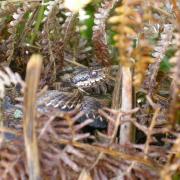Bruce Fogle on the damage modern insecticides have made on our natural world
When I lived outside Horsham, I knew spring was here when tadpoles, seemingly spontaneously, appeared in the tiny pond in our paved front garden. If I ever arrived at my wife Julia’s parent’s bungalow in Sayers Common when my in-laws were out I knew where a key was hidden by a drain - but as often as not I grabbed a corpulent toad, not the key, when I blindly felt for it. When I moved to Ford 30 years ago, I was mightily impressed by the nightly frog wardens on Tye Lane in nearby Walberton; volunteer Lollypop ladies and gentlemen guiding frogs on their hazardous hop across the road to their breeding pond. But if I see an amphibian in Sussex today, I take a picture and post it on Instagram. In the last 40 years numbers of common frogs and toads have dropped by 70%. What’s up?
Most of us are aware of the varied reasons that hedgehog numbers have dramatically fallen. Frogs and toads may be disappearing for similar reasons: the tidy way we maintain our gardens, intensive agriculture, new housing developments fragmenting the frog’s and toad’s environment, but there’s another unexpected possible cause - your desire to keep your dog flea free!
Nicotine is naturally produced by some plants, to protect themselves from being eaten by insects. In the 1980s scientists created synthetic nicotines, called neonicotinoids, and by the 1990s these were marketed as insecticides, to protect arable crops. While very effective crop protectors, these chemicals caused unexpected problems. They were implicated in ‘colony collapse disorder’ in honeybees and by 2018 the EU banned their use in agriculture. We did too. They weren’t banned as ‘spot-on’ anti-flea treatments for dogs and cats because there was an assumption that there were likely to be fewer environmental impacts due to the amount of product used and the animals they were used on.
In 2019 Dr Rosemary Perkins, a vet and Phd student at the University of Sussex, found widespread contamination of English rivers with two neurotoxic pesticides used in dog anti- flea products and the greatest concentrations were downstream from sewage works. She found fipronil (never used in agriculture) in 98% of water samples and imidacloprid in 66% of samples.
Researchers at the University of Grenoble in France discovered that fipronil doesn’t detoxify well in frogs and accumulates in their ovaries. This could explain how frog reproduction is influenced by this chemical.
Imidacloprid and fipronil are powerful insect killers. One monthly flea treatment of a Labrador contains enough imidacloprid to kill 25 million bees. In aquatic ecosystems insect larvae are important food for frogs and toads. Is this how the chemical finds its way into their ovaries?
By weight, imidacloprid is one of the best-selling veterinary parasiticides in the UK. The chemical may be banned from agriculture but more than 2500 kilograms is sold yearly, destined for the dog and cat market as a parasiticide.
In 2002 a beautifully designed ‘toad tunnel’ was built under the A283 just outside Petworth Park, to help frogs migrate to the large pond in the park. The charity Froglife’s research shows that two out of three amphibia that start a trip through a toad tunnel keep on hopping. Only one in three turn back. But the A283 tunnel was a dud. Local frogs and toad failed to turn up and it’s no longer maintained.
At the RSCPA Sussex West Mount Noddy Animal Centre, there is a policy of always investigating the effects on the environment before using any insecticide or herbicide. We’re coming into the flea season right now. If you have a dog or cat, think about what your individual pet’s risks and needs are before using any parasite-control chemicals. They are effective when needed but just as we are being more sensible about using antibiotics only when really required we should be doing the same with insecticides.



























